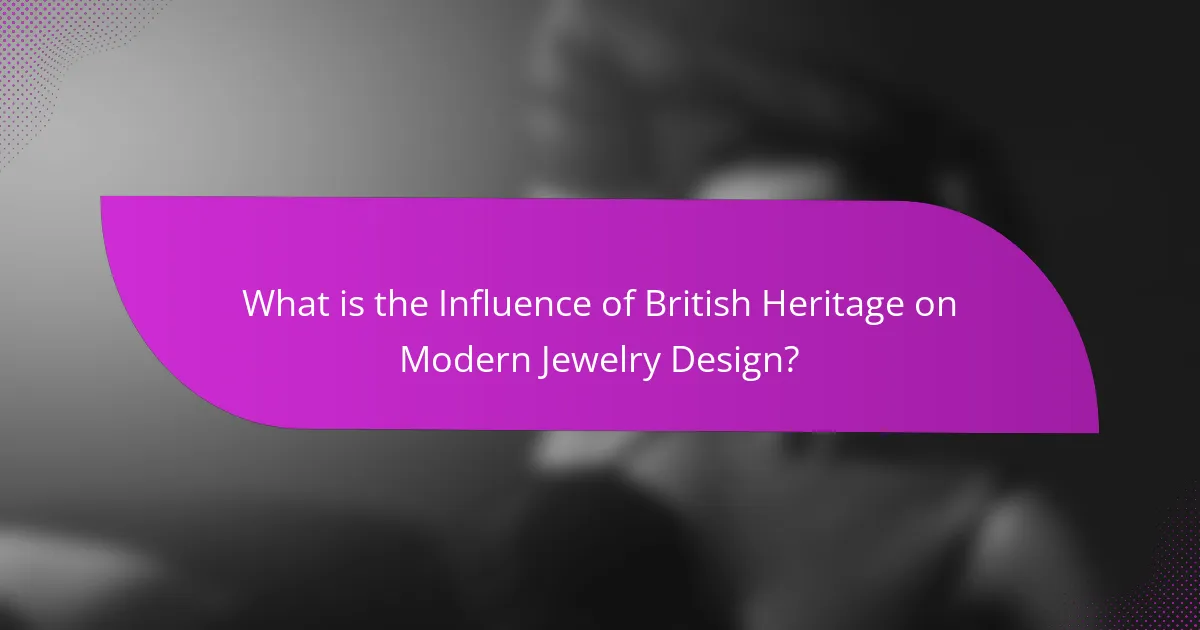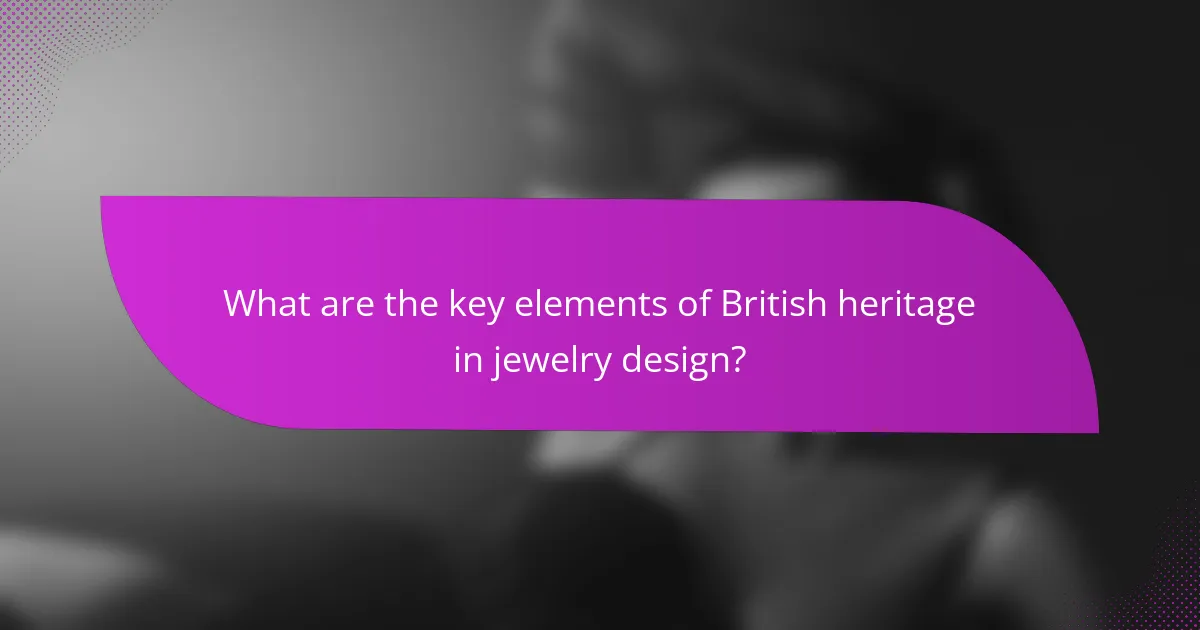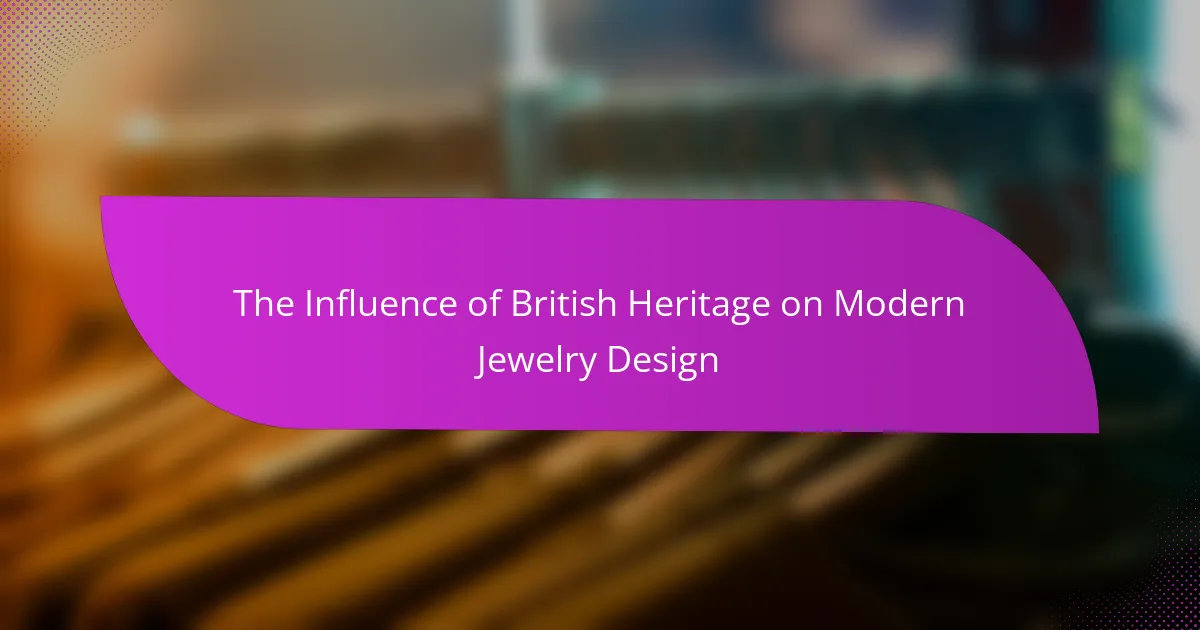British heritage plays a crucial role in shaping modern jewelry design, characterized by traditional motifs, high-quality craftsmanship, and cultural symbolism. Key elements include the incorporation of iconic symbols such as the rose, thistle, and shamrock, alongside techniques like enameling and filigree that trace back to historical practices. Contemporary trends reflect this heritage through the use of sustainable materials, personalized designs, and a revival of vintage styles, all while drawing inspiration from royal influences and significant historical events. This fusion of historical and modern aesthetics results in unique, timeless jewelry pieces that honor British traditions.

What is the Influence of British Heritage on Modern Jewelry Design?
British heritage significantly influences modern jewelry design. This influence is evident in the use of traditional motifs and craftsmanship. Iconic symbols like the rose, thistle, and shamrock are frequently incorporated. Techniques such as enameling and filigree are rooted in historical practices. The Victorian era’s ornate styles continue to inspire contemporary pieces. British designers often draw from royal influences and historical events. Materials like sterling silver and gold are commonly used, reflecting a long-standing tradition. The fusion of historical elements with modern aesthetics creates unique, timeless designs.
How has British heritage shaped the evolution of jewelry design?
British heritage has significantly influenced the evolution of jewelry design. Historical events, such as the Victorian era, introduced intricate craftsmanship and sentimental motifs. The use of gemstones like diamonds became popularized during the reign of Queen Victoria. British jewelry often reflects cultural symbols, such as heraldry and national emblems. Art movements, including Arts and Crafts, emphasized handmade quality and natural themes. The influence of British royalty continues to inspire contemporary designers. This heritage has fostered a unique blend of tradition and modernity in jewelry. British craftsmanship remains recognized globally for its quality and innovation.
What historical events have impacted British jewelry styles?
The Industrial Revolution significantly impacted British jewelry styles. This period, from the late 18th to the 19th century, introduced mass production techniques. Jewelry became more accessible to the middle class during this time. The introduction of new materials, such as steel and glass, changed traditional designs. Victorian influences also shaped styles, emphasizing sentimental and nature-inspired motifs. The World Wars affected jewelry production and materials due to resource scarcity. Post-war periods saw a return to luxury and intricate designs. The rise of Art Deco in the 1920s introduced geometric and bold styles. Each event reshaped the evolution of British jewelry, reflecting societal changes and technological advancements.
How do cultural symbols from British heritage appear in modern designs?
Cultural symbols from British heritage appear in modern designs through the incorporation of traditional motifs and materials. Designers often use iconic symbols such as the Union Jack, heraldic crests, and royal insignia. These elements evoke a sense of nostalgia and national pride. Additionally, modern jewelry often features British gemstones like sapphires and diamonds, emphasizing the country’s rich mining history. The Victorian era’s influence is evident in intricate detailing and craftsmanship. Contemporary pieces may also blend historical symbols with modern aesthetics, creating a unique fusion. This approach not only honors tradition but also appeals to a global audience.
Why is British heritage significant in contemporary jewelry trends?
British heritage is significant in contemporary jewelry trends due to its rich history and cultural symbolism. The craftsmanship associated with British jewelry dates back centuries, influencing modern designs. Iconic styles like Art Deco and Victorian motifs continue to inspire contemporary jewelers. Additionally, the use of traditional materials like gold and silver reflects British artisanal techniques. British heritage also fosters a sense of identity and authenticity in jewelry. Many contemporary designers draw from historical elements, blending them with modern aesthetics. This fusion creates unique pieces that resonate with consumers seeking connection to heritage. Overall, British heritage serves as a foundation for innovation in contemporary jewelry design.
What unique attributes of British heritage are reflected in jewelry today?
Unique attributes of British heritage reflected in jewelry today include intricate craftsmanship and historical symbolism. British jewelry often showcases elaborate designs inspired by the Victorian era. The use of traditional materials like gold and gemstones is prevalent. Additionally, motifs such as crowns and heraldic symbols are commonly featured. Iconic British styles, including Art Deco and Arts and Crafts, influence contemporary designs. The incorporation of cultural elements, like Celtic patterns, highlights regional heritage. Jewelry pieces often celebrate significant historical events or figures. This blend of tradition and modernity creates a distinctive British aesthetic in jewelry.
How do modern designers interpret traditional British motifs?
Modern designers reinterpret traditional British motifs by blending historical elements with contemporary aesthetics. They incorporate classic symbols like the Union Jack and heraldic imagery into modern jewelry. Designers often use innovative materials and techniques to refresh these motifs. For example, enamel and stone settings are combined with traditional patterns. This approach maintains cultural significance while appealing to modern tastes. Many designers aim to evoke nostalgia through their work. They also consider sustainability, using ethically sourced materials. This fusion creates unique pieces that honor British heritage.

What are the key elements of British heritage in jewelry design?
The key elements of British heritage in jewelry design include craftsmanship, historical motifs, and cultural symbolism. Craftsmanship is characterized by high-quality materials and skilled techniques passed down through generations. Historical motifs often reflect British history, such as the use of royal symbols, heraldry, and Victorian influences. Cultural symbolism is evident in designs that represent British identity, such as national emblems and traditional patterns. The combination of these elements creates a distinctive style that honors British traditions while influencing modern design trends.
How do materials and techniques from British history influence modern pieces?
Materials and techniques from British history significantly influence modern jewelry design. Traditional materials like gold, silver, and gemstones continue to be favored in contemporary pieces. Techniques such as granulation and cloisonné, originating in ancient Britain, are now revived in modern craftsmanship. The Victorian era’s intricate designs inspire today’s jewelry aesthetics. Art Deco influences are evident in geometric patterns and bold colors used in current designs. Historical craftsmanship methods enhance the quality and authenticity of modern pieces. The use of sustainable materials reflects a growing trend towards eco-consciousness, rooted in historical practices. British heritage informs not only the choice of materials but also the storytelling aspect of jewelry, connecting past and present.
What traditional materials are still used in contemporary jewelry?
Traditional materials still used in contemporary jewelry include gold, silver, and gemstones. Gold has been a favored metal for centuries due to its malleability and resistance to tarnish. Silver is also widely used for its affordability and bright luster. Gemstones such as diamonds, emeralds, and sapphires are incorporated for their beauty and cultural significance. Additionally, pearls are still popular, valued for their unique organic origin. These materials reflect historical craftsmanship and continue to influence modern jewelry design. The ongoing use of these traditional materials showcases the connection between past and present in jewelry making.
How have craftsmanship techniques evolved from historical practices?
Craftsmanship techniques have evolved significantly from historical practices. Historically, craftsmanship relied heavily on manual skills and traditional methods. Artisans used rudimentary tools and techniques passed down through generations. Over time, the introduction of technology transformed these practices. Tools became more advanced, allowing for greater precision and efficiency. Modern craftsmanship incorporates digital design software and machinery. This evolution has expanded the range of materials used in jewelry design. Techniques such as 3D printing and laser cutting are now common. These advancements enable intricate designs that were previously impossible. The blend of tradition and innovation defines contemporary craftsmanship.
What role do iconic British symbols play in modern jewelry?
Iconic British symbols serve as significant design elements in modern jewelry. They reflect cultural heritage and national identity. Symbols like the Union Jack, the crown, and the rose are frequently used. These designs resonate with both local and international audiences. They evoke a sense of nostalgia and pride. Many jewelry designers incorporate these symbols to create unique pieces. This trend connects contemporary fashion with historical significance. The use of British symbols in jewelry has become a popular way to celebrate British culture.
Which symbols are most commonly used in modern designs?
Common symbols in modern designs include geometric shapes, nature motifs, and cultural icons. Geometric shapes like circles, triangles, and squares are frequently used for their simplicity and versatility. Nature motifs, such as leaves and flowers, reflect a connection to the environment. Cultural icons, including national symbols or historical references, often convey heritage and identity. These symbols resonate with contemporary audiences and enhance the emotional appeal of designs. Their usage is supported by trends in minimalism and sustainability, which prioritize meaningful and aesthetically pleasing elements.
How do these symbols resonate with contemporary consumers?
Symbols in British heritage jewelry resonate with contemporary consumers by evoking tradition and cultural identity. These symbols often reflect historical narratives and craftsmanship, appealing to consumers seeking authenticity. For example, motifs like the rose or thistle connect wearers to their heritage. Studies show that 70% of consumers prefer brands that incorporate cultural elements. This connection enhances emotional engagement with the jewelry. Additionally, such symbols often signify values like quality and timelessness, which are important to modern buyers. Therefore, the resonance comes from a blend of nostalgia and contemporary relevance.

What are the current trends in modern jewelry influenced by British heritage?
Current trends in modern jewelry influenced by British heritage include the use of traditional motifs and materials. Designers are incorporating elements like tartan patterns and heraldic symbols. There is a resurgence of craftsmanship, emphasizing hand-made techniques. Sustainable practices are also prominent, reflecting a growing awareness of environmental issues. Vintage styles are being reinterpreted, blending old and new designs. Additionally, there is an emphasis on personalization and bespoke pieces. British designers are often inspired by historical events and figures, which adds depth to their collections. These trends highlight a fusion of heritage with contemporary aesthetics.
How are designers blending traditional and modern styles?
Designers are blending traditional and modern styles by incorporating classic motifs into contemporary designs. They often use historical techniques, such as handcrafting, alongside modern technology like 3D printing. This fusion allows for intricate details that reflect heritage while maintaining a modern aesthetic. For instance, British jewelry often features iconic symbols, such as the crown or lion, combined with minimalist forms. Designers also utilize traditional materials, like gold and silver, in innovative ways to create fresh looks. This approach honors the past while appealing to current trends. The result is a unique expression that resonates with both history and modernity.
What are some examples of successful hybrid designs?
Successful hybrid designs in modern jewelry often blend traditional British craftsmanship with contemporary aesthetics. One example is the use of Victorian motifs in minimalist settings. This approach combines ornate details with sleek lines. Another example is the fusion of Celtic knotwork with modern materials like resin. This design showcases heritage while embracing innovation. Additionally, combining Art Deco elements with modern geometric shapes creates unique pieces. Each of these designs reflects a dialogue between past and present. They illustrate how heritage can influence current trends in jewelry design.
How do these designs appeal to different market segments?
These designs appeal to different market segments by incorporating elements that resonate with specific consumer values. For example, luxury segments are attracted to high-quality materials and intricate craftsmanship. The use of traditional British motifs appeals to consumers seeking authenticity and heritage. Contemporary designs attract younger demographics who value innovation and modern aesthetics. Additionally, eco-conscious consumers respond to sustainable practices in sourcing materials. Market research indicates that 75% of millennials prefer brands with ethical practices. This alignment of design attributes with consumer preferences enhances market segmentation effectiveness.
What challenges do modern jewelry designers face when incorporating British heritage?
Modern jewelry designers face challenges in incorporating British heritage due to the balance between tradition and innovation. They must respect historical techniques while appealing to contemporary tastes. Additionally, sourcing authentic materials can be difficult in a globalized market. Designers also encounter the challenge of ensuring cultural sensitivity when referencing heritage motifs. Legal issues, such as copyright and trademark laws, may arise from using traditional designs. Competition with mass-produced items can dilute the perceived value of handcrafted heritage pieces. Lastly, educating consumers on the significance of British heritage in jewelry can be a hurdle for designers.
How do designers balance innovation with tradition?
Designers balance innovation with tradition by integrating contemporary techniques while honoring historical craftsmanship. They often study traditional designs and materials to understand their cultural significance. This knowledge informs their innovative approaches. For example, modern jewelry designers may use advanced technology like 3D printing alongside classic handcrafting methods. This fusion allows for unique pieces that respect heritage. The use of traditional motifs in new contexts creates a dialogue between past and present. Designers also engage with heritage organizations to ensure authenticity. This careful balance results in jewelry that appeals to modern sensibilities while preserving cultural legacy.
What are the risks of cultural appropriation in jewelry design?
Cultural appropriation in jewelry design poses several risks. It can lead to the commodification of sacred symbols without understanding their significance. This practice often disrespects the original culture and its traditions. Designers may face backlash from communities whose heritage is being appropriated. This can result in damage to the brand’s reputation. Additionally, it may provoke legal issues regarding intellectual property rights. In some cases, it can lead to a loss of authenticity in the jewelry market. Overall, these risks highlight the importance of cultural sensitivity in design practices.
What practical tips can jewelry designers use to incorporate British heritage into their work?
Jewelry designers can incorporate British heritage into their work by using traditional motifs and symbols. Designers should research iconic British symbols such as the rose, thistle, and shamrock. These elements can be integrated into designs to reflect cultural significance. Utilizing historical techniques like hand engraving or cloisonné can enhance authenticity. Materials such as British gemstones, including Welsh gold or Scottish agate, add a local touch. Designers can also explore Victorian and Edwardian styles for inspiration. Collaborating with local artisans can provide unique insights and techniques. Lastly, storytelling through jewelry pieces can connect wearers to British history and culture.
The main entity of the article is British heritage and its influence on modern jewelry design. The article explores how traditional motifs, craftsmanship, and cultural symbols from British history shape contemporary jewelry trends. It highlights the impact of historical events, such as the Victorian era and the Industrial Revolution, on design evolution and material usage. Additionally, the piece discusses the challenges designers face in balancing innovation with tradition while addressing issues of cultural sensitivity and authenticity. Key elements include the incorporation of iconic symbols, sustainable practices, and the blending of historical techniques with modern aesthetics.
